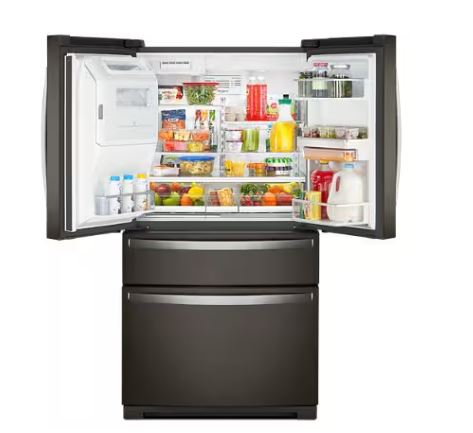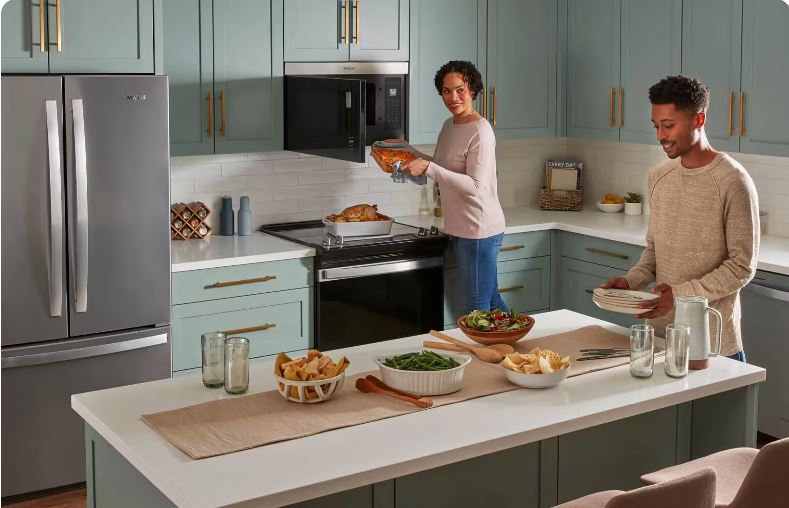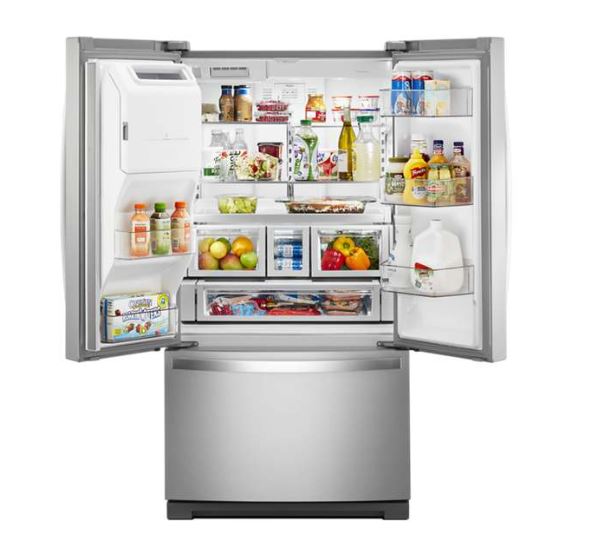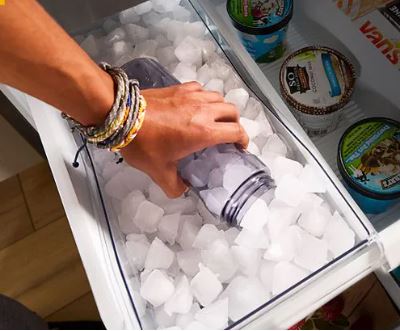Standing in the appliance store staring at dozens of refrigerators, you keep coming back to Whirlpool. Maybe it’s because your grandparents had one that lasted 25 years, or because the price seems reasonable compared to flashier brands.
But is that old reputation still valid in 2026? The appliance industry has changed dramatically, with manufacturing shifting overseas and planned obsolescence becoming the norm.
Whirlpool claims to be America’s most trusted appliance brand, but marketing slogans don’t keep your food cold. This guide cuts through the hype to examine real-world reliability, manufacturing quality, and whether Whirlpool still deserves its reputation as a dependable workhorse brand.

In short, are Whirlpool refrigerators good?
Yes, Whirlpool refrigerators are good appliances that prioritize reliability and value over cutting-edge features. They consistently rank in the top 3 for dependability among major brands, with failure rates of 7-9% in the first five years – significantly better than Samsung (12%) or LG (11%). While they lack some smart features found in premium brands, their straightforward design translates to fewer repairs and longer lifespans of 15-20 years.
Quick Assessment: Whirlpool Refrigerator Performance Summary
| Category | Rating | Details |
| Overall Quality | 8/10 | Solid construction with focus on durability |
| Reliability | 8.5/10 | Top-tier dependability; minimal service calls |
| Features | 6.5/10 | Basic functionality; limited smart options |
| Energy Efficiency | 7.5/10 | Good but not industry-leading |
| Price Value | 9/10 | Excellent value for reliability offered |
| Customer Service | 7.5/10 | Responsive with extensive service network |
| Lifespan | 15-20 years | Above industry average for longevity |
Understanding Whirlpool Refrigerator Quality Standards
Whirlpool takes a fundamentally different approach to refrigerator design than competitors. Their philosophy prioritizes proven technology over trendy features.
Whirlpool’s Design Philosophy: Reliability First
Whirlpool engineers focus on maximizing uptime rather than adding flashy features. Their refrigerators use time-tested components that have proven themselves over decades.
This conservative approach means you won’t find knock-to-see-inside glass or built-in coffee makers. Instead, you get compressors designed for 20+ years of continuous operation.
The company invests heavily in component testing. Each refrigerator undergoes 100+ quality checks before leaving the factory.
How Whirlpool Build Quality Differs from Competitors
Whirlpool uses heavier-gauge steel for internal frameworks compared to budget brands. This prevents warping and maintains door alignment over time.
Shelving systems feature reinforced glass with metal supports. They’re rated for 50+ pounds per shelf versus 35-40 pounds for most competitors.
Cabinet insulation averages 2.5 inches thick. This exceeds Energy Star minimums and keeps temperatures more stable during power fluctuations.
Door gaskets use higher-durometer rubber that maintains flexibility in cold conditions. This prevents the cracking common in cheaper seals after 5-7 years.
Material Choices That Impact Longevity
The company sources compressors from its own manufacturing division rather than third-party suppliers. This vertical integration ensures consistent quality control.
Interior plastic components use ABS rather than cheaper polypropylene. ABS resists cracking at low temperatures and handles impact better.
Evaporator coils feature copper construction in higher-end models. Budget lines use aluminum, which transfers heat less efficiently but costs 40% less.
Water line fittings employ brass connections on premium models. These resist corrosion better than the plastic fittings common in entry-level units.
Who Makes Whirlpool Refrigerators? Brand Ownership and History
Understanding Whirlpool’s corporate structure reveals why their refrigerators maintain consistent quality. The company’s history shapes its current manufacturing practices.
Whirlpool Corporation: The Parent Company
Whirlpool Corporation is an American multinational manufacturer headquartered in Benton Harbor, Michigan. Founded in 1911 as the Upton Machine Company, it’s been producing refrigerators since 1948.
The company operates independently without private equity ownership. This allows long-term planning focused on reputation rather than quarterly profit maximization.
Whirlpool’s 2025 annual revenue exceeded $19 billion. They employ approximately 59,000 people across 15 countries worldwide.
The corporation owns several appliance brands including KitchenAid, Maytag, Amana, and Jenn-Air. Whirlpool-branded products represent their mainstream value proposition.

Whirlpool’s Brand Portfolio and Market Position
KitchenAid serves the premium segment with commercial-grade components. Maytag targets buyers seeking durability with 10-year parts warranties.
Amana occupies the budget-friendly space with simplified features. Jenn-Air competes in the luxury market with high-end finishes and advanced technology.
This brand hierarchy lets Whirlpool serve every price point. However, the Whirlpool brand itself aims squarely at middle-class families prioritizing reliability.
Consumer Reports consistently ranks Whirlpool among the top 3 brands for refrigerator reliability. J.D. Power’s 2025 survey placed them second in customer satisfaction.
Where Are Whirlpool Refrigerators Made? Manufacturing Locations
Whirlpool maintains seven refrigerator manufacturing facilities globally. The primary U.S. plant is in Amana, Iowa, producing over 2 million units annually.
A second major facility operates in Greenville, Ohio, focusing on side-by-side and French door models. This plant employs 2,100 workers and opened in 1955.
Fort Smith, Arkansas houses a components manufacturing center. This facility produces compressors, evaporators, and control systems for North American assembly plants.
International production occurs in Pune, India; Wrocław, Poland; and Monterrey, Mexico. These plants serve their respective regional markets.
Whirlpool invested $60 million in Ohio facility upgrades during 2024-2025. The modernization focused on automation while maintaining U.S. employment levels.
Quality Differences Between Manufacturing Facilities
U.S.-made Whirlpool refrigerators show slightly lower failure rates than imported models. Industry data suggests a 1-2% reliability advantage for domestic production.
The Iowa plant uses more automated assembly with vision-based quality control. This reduces human error during critical fastening and sealing operations.
Mexican-manufactured units meet the same engineering specifications. However, some technicians report minor differences in wire harness routing and insulation application.
European facilities produce models tailored to 220V electrical systems and narrower dimensions. These units aren’t sold in North American markets.
You can identify manufacturing location by checking the serial number plate inside your refrigerator. The first letter indicates the plant: “A” for Amana, “G” for Greenville, etc.
Are Whirlpool Refrigerators Reliable? Real-World Performance Data
Reliability represents Whirlpool’s strongest selling point. Actual service data tells a compelling story about their dependability.
Whirlpool Reliability Rankings Among Major Brands
Yale Appliance’s 2025 service data tracked 38,000 refrigerator installations. Whirlpool ranked second overall with a 7.2% first-year service rate.
Only Bosch performed better at 5.8% failure rate. Samsung, LG, and Frigidaire all exceeded 10% first-year service calls.
Consumer Reports’ 2026 refrigerator reliability survey included 92,000 responses. Whirlpool earned “Very Good” ratings for predicted reliability across most categories.
Service call rates by brand (first 5 years):
- Bosch: 5.8%
- Whirlpool: 7.2%
- GE: 8.9%
- Frigidaire: 10.3%
- LG: 11.1%
- Samsung: 12.4%
The most common Whirlpool repairs involve ice maker assemblies (3.2% of units) and defrost timers (1.8% of units). These are relatively inexpensive fixes averaging $150-250 including labor.
What Makes Whirlpool More Reliable Than Competitors
Whirlpool employs simpler designs with fewer electronic components. Their top-freezer models use mechanical thermostats that rarely fail.
The company sources higher-quality capacitors and relays. These electrical components handle power surges better than cheaper alternatives.
Compressor mounting systems use reinforced rubber isolators. This reduces vibration stress that can cause premature failures.
Quality control includes 100% electrical testing before shipping. Competitors often use statistical sampling that misses occasional defects.

Common Issues with Whirlpool Refrigerators
Despite strong reliability, Whirlpool isn’t problem-free. Ice makers represent the most frequent complaint across model lines.
The icemaker assembly uses a plastic gear that can strip after years of use. Replacement costs $120-200 including service call.
Door sweating occurs in humid climates when the door gasket doesn’t seal perfectly. This is typically fixable by adjusting door alignment.
Defrost timer failures cause frost buildup in the freezer compartment. The timer costs $40-60, but diagnosis sometimes requires a technician.
Water dispensers can develop slow flow from clogged filters. Most users neglect the 6-month replacement schedule, causing this preventable issue.
How Long Will a Whirlpool Refrigerator Last? Lifespan Analysis
Longevity is where Whirlpool truly shines compared to modern competitors. Their engineering emphasizes long-term durability.
Expected Lifespan by Refrigerator Style
Top-freezer Whirlpool models regularly achieve 18-22 years of service. Their simple design has fewer components to fail.
Side-by-side models typically last 15-18 years with proper maintenance. The through-the-door ice and water systems reduce lifespan slightly.
French door units average 14-17 years. Additional hinges, seals, and dual evaporators create more potential failure points.
Bottom-freezer models fall between 16-19 years. They balance simplicity with modern convenience features.
Average lifespan by model type:
- Top-freezer: 18-22 years
- Bottom-freezer: 16-19 years
- Side-by-side: 15-18 years
- French door: 14-17 years
- Built-in models: 20-25 years
Built-in Whirlpool models with commercial-grade compressors can exceed 25 years. These units cost 2-3x more than freestanding models.
Factors That Extend Whirlpool Refrigerator Lifespan
Proper installation dramatically impacts longevity. Whirlpool requires 1-inch clearance on sides and 2 inches on top for adequate airflow.
Climate control matters significantly. Garage installations in hot climates reduce lifespan by 30-40%.
Coil cleaning every 6 months prevents 60% of premature compressor failures. This simple task takes 15 minutes with a vacuum brush attachment.
Prompt repair of minor issues prevents cascading failures. A failed door gasket forces the compressor to overwork, accelerating wear.
Water quality affects components. Hard water clogs ice makers and corrodes water valves 50% faster than filtered water.
Signs Your Whirlpool Refrigerator Is Nearing End-of-Life
Compressor running continuously indicates declining efficiency. Older units struggle to maintain temperature, driving up electricity costs.
Frequent cycling (starting and stopping every 10-15 minutes) suggests refrigerant loss. Recharging costs $200-400 but may only extend life 1-2 years.
Visible rust on cabinet seams compromises insulation integrity. Moisture intrusion indicates major structural deterioration.
Loud grinding or squealing noises often mean bearing failures. These repairs frequently approach 50% of replacement cost.
Warning signs of imminent failure:
- Compressor runs 80%+ of the time
- Food spoils despite proper temperature settings
- Ice buildup in freezer despite manual defrost
- Water leaking inside refrigerator compartment
- Multiple repairs needed within 12 months
If repair costs exceed $500 on a unit over 12 years old, replacement makes more financial sense. The efficiency improvements alone justify upgrading at that point.

Are Whirlpool French Door Refrigerators Good?
French door models represent Whirlpool’s premium consumer offering. They balance features with the brand’s reliability focus.
Whirlpool French Door Design and Features
Whirlpool’s French door lineup includes 15+ models ranging from $2,200-4,800. The top-selling model (WRF555SDHZ) retails around $2,800.
Standard features include LED lighting, humidity-controlled crispers, and adjustable gallon door bins. Higher-end models add exterior ice/water dispensers.
Counter-depth options provide built-in aesthetics. These sacrifice 2-3 cubic feet of capacity for flush installation.
Accu-Chill temperature management uses sensors to adapt cooling patterns. This maintains more consistent temperatures than single-sensor systems.
Reliability of Whirlpool French Door Models
French door Whirlpool refrigerators show 9-11% service rates in the first 5 years. This exceeds their top-freezer models (6-7%) but beats most competitors’ French door offerings.
The dual cooling system introduces complexity. However, Whirlpool’s conservative engineering keeps failures manageable.
Ice maker issues affect 4-5% of French door units. This is higher than top-freezer models but still below LG (8%) and Samsung (11%) rates.
Door alignment requires occasional adjustment. The center mullion seal needs attention every 2-3 years in some units.
Comparing Whirlpool French Doors to Premium Brands
Whirlpool lacks the smart features found in Samsung and LG French doors. No internal cameras, no apps for remote control.
Build quality matches or exceeds mid-tier competitors. GE Profile offers similar reliability at comparable prices.
Bosch French doors show better reliability (6-7% failure rate) but cost $1,000-2,000 more. For many buyers, Whirlpool provides better value.
KitchenAid French doors (also made by Whirlpool) offer upgraded finishes. Mechanically, they’re nearly identical with 5-year extended warranties.
Best Whirlpool French Door Models for 2026
The WRF535SWHZ offers the best reliability-to-feature balance at $2,400. It has external ice/water dispensing with solid 5-year service history.
For budget-conscious buyers, the WRF532SMHZ at $2,200 omits external dispensing. This eliminates the most common failure point.
The WRF757SDHZ ($3,600) includes temperature-controlled drawer. This premium model maintains Whirlpool’s strong reliability record.
Counter-depth model WRF535SMBM ($3,200) suits remodels. It provides built-in aesthetics without custom cabinetry costs.
Are Whirlpool Side-by-Side Refrigerators Good?
Side-by-side designs were Whirlpool’s bread and butter for decades. They still produce competitive models in this declining category.

Whirlpool Side-by-Side Design Advantages
Side-by-side refrigerators offer excellent freezer access at eye level. This suits families who use frozen foods frequently.
The narrow doors require less clearance to open. This benefits tight kitchen layouts where French doors would block walkways.
Whirlpool’s side-by-sides typically offer 20-26 cubic feet of capacity. They maximize vertical space efficiently.
Through-the-door ice and water dispensing is standard on 90% of models. This convenience feature drives side-by-side popularity.
Reliability Comparison: Side-by-Side vs. Other Styles
Whirlpool side-by-side models show 8-10% service rates in year one. This falls between their top-freezers (6-7%) and French doors (9-11%).
The single compressor design is simpler than dual systems. This reduces potential failure points.
Ice maker service calls affect 3-4% of side-by-side units annually. The through-the-door system adds complexity but Whirlpool’s implementation is solid.
Water valve failures occur in 1-2% of units after 7-10 years. This is an inexpensive repair averaging $150 including service.
Common Problems with Whirlpool Side-by-Side Models
Temperature imbalance between sides affects some older models. One side may cool properly while the other runs warm.
This typically indicates blocked air passages. The fix involves cleaning and ensuring proper air circulation.
Door gasket wear happens faster on side-by-sides due to daily use. Replacement every 8-10 years maintains efficiency.
Ice dispenser chute freezing frustrates owners in humid climates. This creates ice blockages requiring manual clearing.
The water filter housing can crack after many filter changes. Whirlpool redesigned this component in 2023 models to address the issue.
Best Whirlpool Side-by-Side Models for Reliability
The WRS325SDHZ ($1,600) offers exceptional value with proven reliability. It lacks smart features but delivers solid performance.
For larger families, the WRS571CIHZ ($2,100) provides 26 cubic feet. Consumer Reports rates it “Very Good” for predicted reliability.
The WRS588FIHZ ($1,900) includes in-door ice storage. This maximizes shelf space while maintaining dependable operation.
Budget option WRS312SNHM ($1,400) strips features to basics. Its simplicity translates to even lower failure rates around 7%.
Whirlpool vs. Competitors: Comparative Analysis
Understanding how Whirlpool stacks up helps contextualize their value proposition. Different brands excel in different areas.
Whirlpool vs. GE Appliances
GE and Whirlpool compete directly in the mainstream market. Both prioritize reliability over trendy features.
GE shows slightly higher service rates at 8.9% vs. Whirlpool’s 7.2%. However, GE often includes more features at equivalent price points.
Profile series GE models compete with Whirlpool’s standard line. They’re mechanically similar with different brand aesthetics.
GE’s parts availability slightly exceeds Whirlpool’s. Both maintain extensive service networks nationwide.

Whirlpool vs. LG Electronics
LG focuses on innovation while Whirlpool emphasizes proven technology. This creates distinct value propositions.
LG refrigerators include smart features, InstaView glass, and Craft Ice makers. Whirlpool models are more basic but more reliable.
LG’s 11.1% service rate vs. Whirlpool’s 7.2% reflects their complexity. However, LG units offer more premium features.
Energy efficiency favors LG slightly. Their Linear Compressor technology reduces consumption by 15-20% over conventional designs.
Price comparably equipped, with LG charging premium for smart features. Buyers choosing reliability over features prefer Whirlpool.
Whirlpool vs. Frigidaire
Frigidaire competes primarily on price. Whirlpool positions slightly upmarket with better components.
Frigidaire’s 10.3% service rate trails Whirlpool significantly. Build quality differences explain this gap.
Frigidaire uses lighter gauge steel and thinner insulation. This reduces manufacturing costs but compromises longevity.
Whirlpool refrigerators typically outlast Frigidaire by 3-5 years. The initial price premium pays off through extended lifespan.
Both brands offer strong parts availability. However, Whirlpool’s service network is more extensive in rural areas.
Maintenance Tips for Maximum Whirlpool Refrigerator Lifespan
Proper care dramatically extends your refrigerator’s service life. These maintenance practices prevent most common failures.
Critical Maintenance Tasks for Whirlpool Refrigerators
Clean condenser coils biannually:
- Use vacuum with brush attachment
- Removes dust that reduces cooling efficiency
- Access coils behind front grille or rear panel
- Takes 15-20 minutes
- Prevents 60% of compressor failures
Replace water filters every 6 months:
- Don’t wait for “replace filter” light
- Old filters restrict water flow
- Strains water inlet valve
- Generic filters acceptable (verify NSF/ANSI certification)
- Costs $30-50 vs. $200+ valve replacement
Inspect door gaskets quarterly:
- Check for tears, cracks, or hardening
- Clean with mild detergent
- Apply thin petroleum jelly coat annually
- Test seal by closing door on dollar bill
- Should require firm pull to remove
Monitor temperature settings:
- Refrigerator should maintain 37-38°F
- Freezer should stay at 0°F
- Use appliance thermometer for accuracy
- Internal sensors can drift over time
- Adjust seasonally if kitchen temperature varies
Preventing Common Whirlpool Refrigerator Problems
Address water dispensing issues before they escalate. Slow water flow indicates filter or valve problems.
Replace water filters on schedule, not when flow decreases noticeably. By then, damage may have occurred.
Clean door gaskets monthly to maintain proper seal. Food residue prevents complete closure.
Avoid overloading shelves beyond manufacturer ratings. Excessive weight damages supports and creates uneven cooling.
Keep refrigerator away from heat sources. Placement near ovens or in direct sunlight increases compressor workload 20-30%.
When to Call a Professional for Whirlpool Service
Temperature fluctuations despite proper settings require diagnosis. This may indicate refrigerant loss or sensor failure.
Strange noises (grinding, squealing, banging) suggest mechanical problems. Early intervention prevents expensive damage.
Water leaking inside compartment indicates drainage issues. Clogged drain lines can overflow and damage flooring.
Frost buildup in freezer despite auto-defrost means system failure. The defrost timer or heater likely needs replacement.
Signs requiring immediate professional attention:
- Complete cooling failure
- Burning smell or smoke
- Loud grinding/banging noises
- Water pooling under refrigerator
- Error codes displayed on control panel
Whirlpool’s service network includes 10,000+ authorized technicians nationwide. Most areas can schedule service within 3-5 days.

Should You Buy a Whirlpool Refrigerator? Decision Framework
Not every buyer benefits from Whirlpool’s reliability-focused approach. Understanding your priorities helps determine fit.
Ideal Buyers for Whirlpool Refrigerators
Whirlpool suits buyers prioritizing long-term reliability over cutting-edge features. If you plan to keep your refrigerator 15+ years, they’re excellent choices.
Budget-conscious families appreciate the value proposition. You get solid reliability without premium pricing.
Traditional home cooks who don’t need smart features benefit most. Whirlpool focuses on doing the basics exceptionally well.
Rural homeowners value Whirlpool’s extensive service network. Parts availability exceeds most competitors in remote areas.
When to Consider Alternatives Instead
Tech enthusiasts wanting smart features should explore LG or Samsung. Whirlpool’s limited connectivity won’t satisfy them.
Design-focused buyers may find Whirlpool aesthetics plain. European brands like Bosch offer more premium finishes.
Those prioritizing absolute maximum energy efficiency might choose LG. Their Linear Compressor technology edges out Whirlpool.
Commercial settings requiring 24/7 operation need commercial-grade units. True, Sub-Zero, or KitchenAid commercial lines are better suited.
Price-to-Value Analysis
Whirlpool refrigerators range from $800 (basic top-freezer) to $5,000 (premium French door). Most fall in the $1,400-2,800 sweet spot.
At this price range, Whirlpool’s reliability advantage justifies choosing them over Frigidaire or budget GE models. The extended lifespan offsets any initial premium.
Compared to Samsung or LG at similar prices, Whirlpool trades features for dependability. Your priorities determine which is better value.
Premium brands like Bosch offer marginally better reliability. However, their 40-60% price premium rarely justifies the small reliability improvement.
FAQs About Whirlpool Refrigerators
Are Whirlpool refrigerators reliable?
Yes, Whirlpool consistently ranks among the top 3 most reliable refrigerator brands. Their first-year service rate of 7.2% significantly beats industry averages of 10-12%. The brand’s conservative engineering and quality component selection contribute to this strong reliability record.
How long will a Whirlpool refrigerator last?
Whirlpool refrigerators typically last 15-20 years with proper maintenance. Top-freezer models often exceed 20 years, while French door units average 14-17 years. This significantly exceeds the industry average of 10-15 years for major appliances.
Where are Whirlpool refrigerators made?
Whirlpool manufactures refrigerators primarily in Amana, Iowa and Greenville, Ohio for the North American market. Additional production occurs in Fort Smith, Arkansas (components) and Monterrey, Mexico. The serial number plate inside your refrigerator indicates the specific manufacturing plant.
Who makes Whirlpool refrigerators?
Whirlpool Corporation manufactures Whirlpool-branded refrigerators along with KitchenAid, Maytag, Amana, and Jenn-Air brands. The company is an American multinational headquartered in Benton Harbor, Michigan, and has been producing refrigerators since 1948.
Are Whirlpool French door refrigerators good?
Yes, Whirlpool French door models offer good reliability with 9-11% service rates in the first 5 years. While they lack some smart features found in LG or Samsung models, they provide solid performance and longevity at competitive prices. They’re particularly suitable for buyers prioritizing dependability over advanced features.
Are Whirlpool side-by-side refrigerators good?
Whirlpool side-by-side refrigerators perform well with 8-10% first-year service rates. They offer excellent freezer accessibility and suit tight kitchen layouts where narrow doors are beneficial. Their through-the-door ice/water systems are more reliable than most competitors’ implementations.
Do Whirlpool refrigerators have good warranties?
Whirlpool provides a standard 1-year full warranty on parts and labor for all refrigerators. The compressor receives an additional 4-year limited warranty (parts only). While not industry-leading, this coverage is adequate, and the brand’s reliability means you’ll likely need it less than with other manufacturers.
Final Verdict: Should You Choose Whirlpool?
Whirlpool refrigerators excel at their core mission: reliably keeping food cold for decades. If you prioritize dependability, longevity, and value over smart features, they’re among your best options. Their 7.2% failure rate beats most mainstream competitors, and 15-20 year lifespans exceed industry norms.
The brand makes particular sense for traditional households, budget-conscious buyers, and anyone in rural areas where service accessibility matters. Top-freezer and side-by-side models represent especially strong values, while French door units offer modern convenience without sacrificing much reliability.
However, tech enthusiasts, design-focused buyers, or those wanting maximum energy efficiency should explore alternatives like LG, Bosch, or high-end KitchenAid. Whirlpool’s straightforward approach won’t satisfy everyone, but for families seeking a dependable appliance that lasts, few brands deliver better value.
